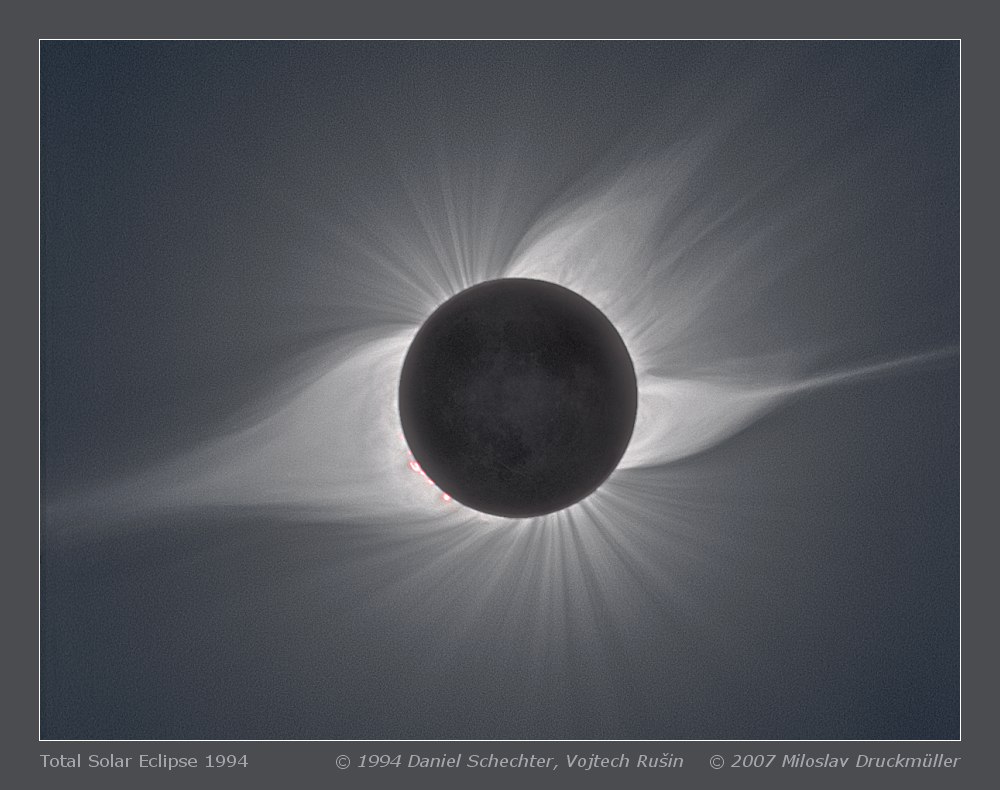
Corona and Earth lit Moon
The diffuse light caused by high cirrus clouds decreased the contrast especially in the
inner corona. Therefore, I was not able to obtain satisfactory contrast at high spatial frequencies in
the innermost part of the corona. Fortunately, there are images by Vojtech Rušin in the MMV project
archive
which were taken only four minutes before the images by Daniel Schechter. Images
by Vojtech Rušin are taken with significantly longer focal length lens and they are on higher
contrast slide film. Combination of these two image sets was therefore optimal. The final image has
acceptable contrast throughout the whole corona. The details on the lunar surface are clearly visible,
which is surprising in those observing conditions. It is the sign that
the influence of the clouds was only minor one. The lunar surface was recorded on images taken by
Daniel Schechter and the alignment was done separately for solar corona and lunar surface.
During the 1994 total solar eclipse, the eleven-year solar activity cycle was drawing
near the minimum. The coronal structure had some features typical for the minimum (see for example 1995 eclipse) but the shape of corona is
of, let us say, "mid-cycle" type. The following graph shows the average values of the relative sunspot number,
in which the red arrow indicates the time of the 1994 eclipse. The graph was created according to
data from Sunspot Index Data Center, Brussels. 
Click on the image or on the following reference to display the
higher resolution image version (1.4 MB, PNG format).
|
| Image | Tse1994srd_cor_mo_1.jpg |
| Date | 03. 11. 1994 |
| Time | R: 2nd contact 12:18:17 UT, 3rd contact 12:21:19 UT
S: 2nd contact 12:22:11 UT, 3rd contact 12:25:18 UT |
| Place | R: Putre, Chile
S: Sevaruyo, Bolivia |
| Coordinate | R: 69° 33' 33'' W, 18° 11' 22'' S, alt. 3479 m
S 19° 25.98', W 66° 51.00', alt. 3728 m |
| Conditions | R: High thin clouds, altitude of the Sun above the horizon 32°
S: High thin clouds, altitude of the Sun above the horizon 36°. |
| Optics | R: Maksutov - Cassegrain MTO 1050/1100mm
S: Astro-Physics 4 inch f/6 Traveller |
| Film | R: Kodak Ektachrome Elite 100 (EB), 24×36mm slide film
S: Kodak Royal Gold 100, 24×36mm negative film |
| Processing | Composition of 15 images (10 S, 5 R). Images were aligned by means of phase correlation technique and then processed using Corona 4.0 software. Final processing was done in ACC 6.0 software.
Image processing by Miloslav Druckmüller |
| Scanner | Nikon Super Coolscan 4000 ED (16× multisample) |
| Software | PhaseCorr 4.0, FilmCMP 2.0, Corona 4.0, Sofo ACC 6.0 |
| Note | R: Denotes Vojtech Rušin
S: Denotes Daniel Schechter |
| Orientation | The image must be rotated 30.7° clockwise to achieve the standard orientation i.e. North top, East left |
| Copyright | © 1994 Daniel Schechter, Vojtech Rušin © 2007 Miloslav Druckmüller |

|
Miloslav Druckmüller
Institute of Mathematics, Faculty of Mechanical Engineering
Brno University of Technology, Czech Republic
druckmuller@fme.vutbr.cz
|
Page last update: 27.11.2019
|
|

